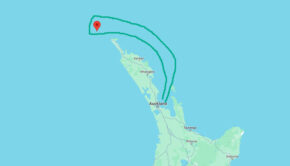Properly informing the Protestee
Published on March 25th, 2020
The Racing Rules of Sailing provides for appeals as a mechanism to correct possible protest committee errors in interpreting the rules. In his role as Chair of the US Sailing Appeals Committee, Dave Perry is eager to bring these appeal decisions out of the back room and into the light.
In Appeal 124, it focuses on the amount of time to display a protest flag to fulfill the requirements of rule 61.1(a) (Protest Requirements: Informing the Protestee).
Ready to learn something? Here we go:
Facts and Decision of the Protest Committee:
Mofongo (S) and Fuzzy Logic (P), two 20-foot keelboats, were sailing upwind in light air with no other boats nearby and were approaching each other on opposite tacks. S bore away to avoid contact with P. S immediately hailed “Protest” and the crew promptly acted to retrieve the protest flag and display it. The flag was displayed 10–15 seconds after the incident.
The protest committee decided that the flag was displayed at the first reasonable opportunity after the incident as required by rule 61.1(a). P appealed that decision claiming that the “first reasonable opportunity” to display a protest flag on boats sailing in open water in light wind should be interpreted as “immediate,” within three to five seconds.
P further claimed that when an on-the-water alternative penalty is available, protested boats should have immediate and complete notification of a boat’s intention to protest, and that 10–15 seconds is too much time and distance sailed to be considered the “first reasonable opportunity” to display the flag.
Decision of the Appeals Committee:
Rule 61.1(a) uses the phrase “first reasonable opportunity.” The word “immediate” does not occur in that rule. Whereas it may be reasonable for a boat to hail “Protest” immediately after an incident (see Appeal 122), it is just as reasonable for it to take a little time for a crew to retrieve and then display a protest flag.
Furthermore, while it is possible to store a flag such that it could be displayed immediately, rule 61.1(a) does not require it. On the other hand, it is also possible to store a flag in such a way that the delay required in retrieving it would not be reasonable.
A protest flag flown 10–15 seconds after an incident when a member of the crew is able to retrieve and display the flag in that time and acts to do so is consistent with displaying the flag at the “first reasonable opportunity.” See also US Sailing Appeals 46, 67 and 82.
P claims that when an on-the-water alternative penalty is available, protested boats should have immediate and complete notification of a boat’s intention to protest. We note that rule 44.2, One-Turn and Two-Turns Penalties, requires a boat intending to take a penalty to get well clear of other boats “as soon after the incident as possible” and then promptly make her turns, and that rule 44.3, Scoring Penalty, requires a boat to display a yellow flag “at the first reasonable opportunity after the incident.”
These rules do not provide time for a boat to wait until she hears the word “Protest” and/or sees a red flag displayed before taking her penalty.
A boat that does not take her penalty in accordance with rules 44.2 or 44.3 risks having her penalty found to be invalid. Furthermore, a boat that realizes at the time of an incident that she broke a rule and does not take her penalty not only risks having her penalty found to be invalid, she also breaks a recognized principle of sportsmanship that requires a boat that realizes she has broken a rule to promptly take a penalty (see Basic Principles, Sportsmanship and the Rules; rule 2, Fair Sailing; and World Sailing Case 138, Answer 3).
P’s appeal is denied. The protest committee’s decision is upheld.
To learn about the Appeals process, click here.









 We’ll keep your information safe.
We’ll keep your information safe.